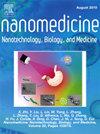双组分t细胞免疫疗法使抗原预靶向减少细胞因子释放而不丧失疗效
IF 4.6
2区 医学
Q2 MEDICINE, RESEARCH & EXPERIMENTAL
Nanomedicine : nanotechnology, biology, and medicine
Pub Date : 2025-04-30
DOI:10.1016/j.nano.2025.102825
引用次数: 0
摘要
当代t细胞免疫疗法,尽管令人印象深刻的靶向精度,阻碍了异常的细胞因子释放和限制性靶向化学计量。我们介绍了一种针对b细胞恶性肿瘤的双组分t细胞免疫疗法:多抗原t细胞杂交(MATCH)。这种分裂抗体技术与目前的治疗方法不同,它将癌细胞靶向成分与T细胞参与成分分离开来。我们证明了这种双组分结构有助于可调的t细胞激活。αCD19和αCD20 MATCH分两步给药,均与临床标准双特异性抗体blinatumumab进行比较。体外二维剂量分析和细胞因子释放数据表明,MATCH可以通过减少细胞因子释放来改善癌症清除。对细胞溶解作用机制进行了评价。采用人淋巴瘤小鼠模型检测αCD20 MATCH的抗癌效果。将t细胞接触剂剂量减少10倍与未减少剂量的效果相当。最终,这种分裂抗体模式可能会增强抗原靶向,同时减少细胞因子的释放,这种安全性和有效性优势将通过未来可能的MATCH多抗原靶向得到增强。本文章由计算机程序翻译,如有差异,请以英文原文为准。

Two-component T-cell immunotherapy enables antigen pre-targeting to reduce cytokine release without forfeiting efficacy
Contemporary T-cell immunotherapies, despite impressive targeting precision, are hindered by aberrant cytokine release and restrictive targeting stoichiometry. We introduce a two-component T-cell immunotherapy targeting B-cell malignancies: Multi-Antigen T-Cell Hybridizers (MATCH). This split antibody technology differs from current therapies by separating cancer cell-targeting components from T cell-engaging components. We demonstrate that this two-component structure facilitates tunable T-cell activation. αCD19 and αCD20 MATCH, administered in two steps, are both compared to the clinical standard bispecific antibody, blinatumomab. In vitro two-dimensional dose analysis and cytokine release data indicate MATCH improves cancer clearance with reduced cytokine release. Cytolytic mechanisms of action are evaluated. αCD20 MATCH anti-cancer efficacy is assayed using a human lymphoma murine model. Decreasing T-cell engager dose 10-fold yields comparable efficacy to non-reduced doses. Ultimately, this split-antibody paradigm may enhance antigen targeting while reducing cytokine release, with such safety and efficacy advantages augmented by the future possibility of multi-antigen targeting with MATCH.
求助全文
通过发布文献求助,成功后即可免费获取论文全文。
去求助
来源期刊
CiteScore
11.10
自引率
0.00%
发文量
133
审稿时长
42 days
期刊介绍:
The mission of Nanomedicine: Nanotechnology, Biology, and Medicine (Nanomedicine: NBM) is to promote the emerging interdisciplinary field of nanomedicine.
Nanomedicine: NBM is an international, peer-reviewed journal presenting novel, significant, and interdisciplinary theoretical and experimental results related to nanoscience and nanotechnology in the life and health sciences. Content includes basic, translational, and clinical research addressing diagnosis, treatment, monitoring, prediction, and prevention of diseases.

 求助内容:
求助内容: 应助结果提醒方式:
应助结果提醒方式:


